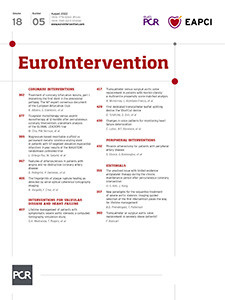The prevalence of obesity is increasing worldwide1. Despite the perceived increased risks associated with being overweight, obese patients with cardiovascular diseases may have a comparable or even better prognosis than patients with a normal or low body mass index (BMI)2. Mariscalco et al3 demonstrated that patients with a BMI 25-40 kg/m2 had a lower risk of early adverse events after cardiac surgery compared to patients with lower BMI3. However, this benefit was lost in patients with BMI >40 kg/m2. Obese patients may also have better early and late outcomes after transcatheter aortic valve replacement (TAVR), as demonstrated by two pooled analyses45. The long life expectancy of obese patients poses a dilemma about the treatment of choice for severe aortic stenosis (AS) in these patients. The minimally invasive nature of TAVR is an argument against surgical aortic valve replacement (SAVR) in obese patients. The lack of data on the durability of transcatheter prostheses may still favour SAVR with prostheses of proven durability, particularly when a minimal access technique is used.
In this issue of the EuroIntervention, McInerney et al6 report the results of a retrospective comparative analysis evaluating the early and 2-year outcomes of patients with morbid obesity who underwent TAVR or SAVR for AS between 2008 and 2019 from a multicentre study. Morbid obesity was defined by BMI ≥40 kg/m2 or ≥35 kg/m2 with obesity-related comorbidities. Propensity score matching resulted in 362 patients with a mean age of 74.0±7.1 years for TAVR patients and 74.2±6.4 years for SAVR patients. The mean BMI of TAVR patients was 39.1±3.8 kg/m2 and 38.8±3.6 kg/m2 for SAVR patients. The other baseline characteristics were well balanced as well. As expected, a large proportion of SAVR patients underwent coronary surgery, while no information about concomitant coronary revascularisation was provided for TAVR patients. TAVR was associated with a lower risk of acute kidney injury, blood transfusion, pneumonia and access site infection. Importantly, the rate of patient-prosthesis mismatch and the post-procedural transvalvular gradient were significantly lower after TAVR. TAVR was associated with an increased risk of pacemaker implantation. In-hospital or 30-day mortality (TAVR 5.3% vs SAVR 6.9%) and major vascular complications (7.5% vs 6.1%) were similar between the study cohorts. At 2 years, all-cause (TAVR 15.9% vs SAVR 14.2%) and cardiovascular mortality (TAVR 10.1% vs SAVR 11.0%) were comparable between TAVR and SAVR, but a decreased freedom from all-cause readmission was observed after SAVR (59.2 vs 64.2%; p=0.055). Similar results were observed among patients treated between 2014 and 2019.
The authors should be congratulated for having performed such a large study. Still, its results should be viewed taking into consideration a number of limitations. Minimally invasive SAVR may improve the early outcome of obese patients78, but this technique was performed in only 7.5% of matched patients. Therefore, these findings may not be generalised to centres with extensive experience in minimally invasive cardiac surgery. Furthermore, the study cohorts were well balanced in terms of prevalence of coronary artery disease, but more than two-thirds of SAVR required coronary surgery, likely because of diffuse coronary artery disease. Data on concomitant revascularisation in TAVR patients and on the severity of coronary artery disease were not provided. A subanalysis of patients with and without coronary artery disease was not performed. While we may expect that patients with morbid obesity and significant frailty were mostly treated with TAVR, this cannot be easily investigated in a retrospective clinical series. Finally, this study included rather young elderly patients with morbid obesity and these findings cannot be translated to patients of advanced age or those with less severe obesity. Bearing in mind these limitations, the present findings will certainly be valuable in the decision-making process regarding the invasive treatment of obese patients with severe AS.
Conflict of interest statement
The author has no conflicts of interest to declare.
Supplementary data
To read the full content of this article, please download the PDF.

